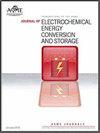高温聚合物电解质膜燃料电池催化剂层组成及结构优化
IF 1.9
4区 工程技术
Q3 ELECTROCHEMISTRY
Journal of Electrochemical Energy Conversion and Storage
Pub Date : 2023-02-24
DOI:10.1115/1.4056990
引用次数: 1
摘要
高温聚合物膜燃料电池(HT PEMFC)由于其加速的电化学反应动力学、简化的水/热管理和提高的杂质耐受性而被认为是PEMFC未来发展的趋势。作为HT-PEMFC膜电极组件的核心部件,催化剂层对HT-PEMFC的成本、性能和寿命有着重要的影响。然而,由于HT-PEMFC中的高温和酸性环境,铂(Pt)催化剂的降解和碳腐蚀加速。此外,在长期操作后观察到用作质子导体的磷酸(PA)的损失。此外,磷酸盐在Pt表面的吸附导致Pt利用率低。因此,HT-PEMFC的商业化必须解决高成本和快速性能衰减的问题。优化催化剂层的组成和结构被证明是解决这些问题的有效策略。在这篇综述中,我们首先总结了HT-PEMFC催化剂层组成优化的最新进展,包括催化剂、粘合剂、电解质(PA)和添加剂。然后,介绍了催化剂层的结构特点,并对优化策略进行了综述。最后,讨论了HT-PEMFC催化剂层的研究现状和面临的挑战。本文章由计算机程序翻译,如有差异,请以英文原文为准。
Optimization on composition and structure of catalyst layer for high-temperature polymer electrolyte membrane fuel cells
High-temperature polymer membrane fuel cells (HT-PEMFCs) are considered as the trend of PEMFC future development due to their accelerated electrochemical reaction kinetics, simplified water/thermal management, and improved tolerance to impurities (CO). As the core part of membrane electrode assembly in HT-PEMFC, the catalyst layer significantly affects the cost, performance, and lifetime of HT-PEMFC. However, due to the high temperature and acid environment in HT-PEMFC, platinum (Pt) catalyst degradation and carbon corrosion are accelerated. Moreover, the loss of phosphoric acid (PA) which serves as the proton conductor is observed after long-term operation. In addition, the adsorption of phosphate on Pt surface leads to the poor Pt utilization. Thus, high cost and fast performance decay must be addressed for the commercialization of HT-PEMFC. Optimizing the composition and structure of catalyst layer are demonstrated as effective strategies to resolve the problems. In this review, we first summarize the latest progress in the optimization of catalyst layer composition for HT-PEMFC, including catalysts, binders, electrolyte (PA), and additives. Thereafter, the structural characteristics of catalyst layer are introduced and the optimization strategies are reviewed. Finally, the current challenges and research perspectives of catalyst layer in HT-PEMFC are discussed.
求助全文
通过发布文献求助,成功后即可免费获取论文全文。
去求助
来源期刊

Journal of Electrochemical Energy Conversion and Storage
Engineering-Mechanics of Materials
CiteScore
4.90
自引率
4.00%
发文量
69
期刊介绍:
The Journal of Electrochemical Energy Conversion and Storage focuses on processes, components, devices and systems that store and convert electrical and chemical energy. This journal publishes peer-reviewed archival scholarly articles, research papers, technical briefs, review articles, perspective articles, and special volumes. Specific areas of interest include electrochemical engineering, electrocatalysis, novel materials, analysis and design of components, devices, and systems, balance of plant, novel numerical and analytical simulations, advanced materials characterization, innovative material synthesis and manufacturing methods, thermal management, reliability, durability, and damage tolerance.
 求助内容:
求助内容: 应助结果提醒方式:
应助结果提醒方式:


